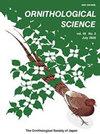印度西海岸河口滨鸟群落的时空格局
IF 0.3
4区 生物学
Q4 ORNITHOLOGY
引用次数: 5
摘要
摘要印度海岸及其邻近的湿地聚集着大量的滨鸟,包括中亚飞行路线沿线的冬季和重点保护的迁徙鸟类。确定重要的越冬和中途停留地点和季节是保护印度海岸滨鸟及其栖息地的重要一步。我们评估了2015年1月至2016年12月马哈拉施特拉邦Sindhudurg区七个河口的滨鸟组成的空间和时间模式,该区位于印度西海岸,是对滨鸟具有国际重要性的沿海地区。在为研究选择的每个河口都选择了三个潜在的滨鸟栖息地——红树林、泥滩和沙滩。我们建立了三个有利位置,分别位于红树林、滩涂和沙滩区,以便在退潮时计数鸟类。鸟类计数采用总计数法,当鸟群较大或不断变化时,偶尔也会进行基于照片的计数。我们记录了31种迁徙滨鸟,其中68%的滨鸟越冬,32%的滨鸟将辛杜尔格海岸作为迁徙中途停留地。我们发现,在冬季和泥滩中,滨鸟的丰富度和丰度都非常高。nMDS用于确定不同栖息地和月份的滨鸟物种组成,并揭示了五个独特阶段的不同组成模式:到达、越冬、提前离开、离开和繁殖。我们的研究结果表明,滨鸟的物种组成在不同地点和月份并不同质,这在很大程度上是由河口的栖息地异质性、季节性和人为干扰所驱动的。这些结果提供了印度西海岸沿岸滨鸟的基线信息,并强调了泥滩和未受保护的沿海湿地对滨鸟的重要性。本文章由计算机程序翻译,如有差异,请以英文原文为准。
Spatial and Temporal Patterns of Shorebird Assemblages in Select Estuaries along the India's West Coast
Abstract The Indian coast and its adjacent wetlands host large congregations of shorebirds, including winter and passage migrants of high conservation priority, along the Central Asian Flyway. Identifying crucial wintering and stopover sites and seasons is an important step toward conserving shorebirds and their habitats along the Indian coast. We assessed spatial and temporal patterns of shorebird composition from January 2015 to December 2016 at seven estuaries along Maharashtra's Sindhudurg district, which is located on India's west coast, a coastal zone of international importance for shorebirds. Three potential shorebird habitats –mangroves, mudflats, and sandy beaches – were selected at each of the estuaries chosen for the study. We established three vantage points, one each in the mangrove, mudflat, and sandy beach areas, to count birds during low tide. The total count method was followed to count birds, and occasional photograph-based counts were also made when flock size was big or the flocks kept changing. We recorded 31 species of migratory shorebirds, of which 68% wintered and 32% used the Sindhudurg coast as migratory stopover site. We found significantly high richness and abundance of shorebirds during winter and in the mudflats. nMDS was used to determine species composition of shorebird across habitats and months and revealed distinct patterns of composition in five unique phases: arrival, wintering, early departure, departure, and breeding. Our results revealed that the species composition of shorebirds is not homogenous across sites and months, and is largely driven by the habitat heterogeneity of estuaries, seasonality, and anthropogenic disturbances. These results provide baseline information on shorebirds along a stretch of India's west coast and highlight the importance of mudflats and non-protected coastal wetlands for shorebirds.
求助全文
通过发布文献求助,成功后即可免费获取论文全文。
去求助
来源期刊

Ornithological Science
ORNITHOLOGY-
CiteScore
1.20
自引率
0.00%
发文量
26
审稿时长
>12 weeks
期刊介绍:
Ornithological Science publishes reviews, original articles, short communications and comments covering all aspects of ornithology. Manuscripts are judged on the basis of their contribution of original data and ideas or interpretation. All articles are peer-reviewed by at least two researchers expert in the field of the submitted paper. Manuscript are edited where necessary for clarify and economy. Ornithological Science aims to publish as rapidly as is consistent with the requirements of peer-review and normal publishing constraints.
 求助内容:
求助内容: 应助结果提醒方式:
应助结果提醒方式:


